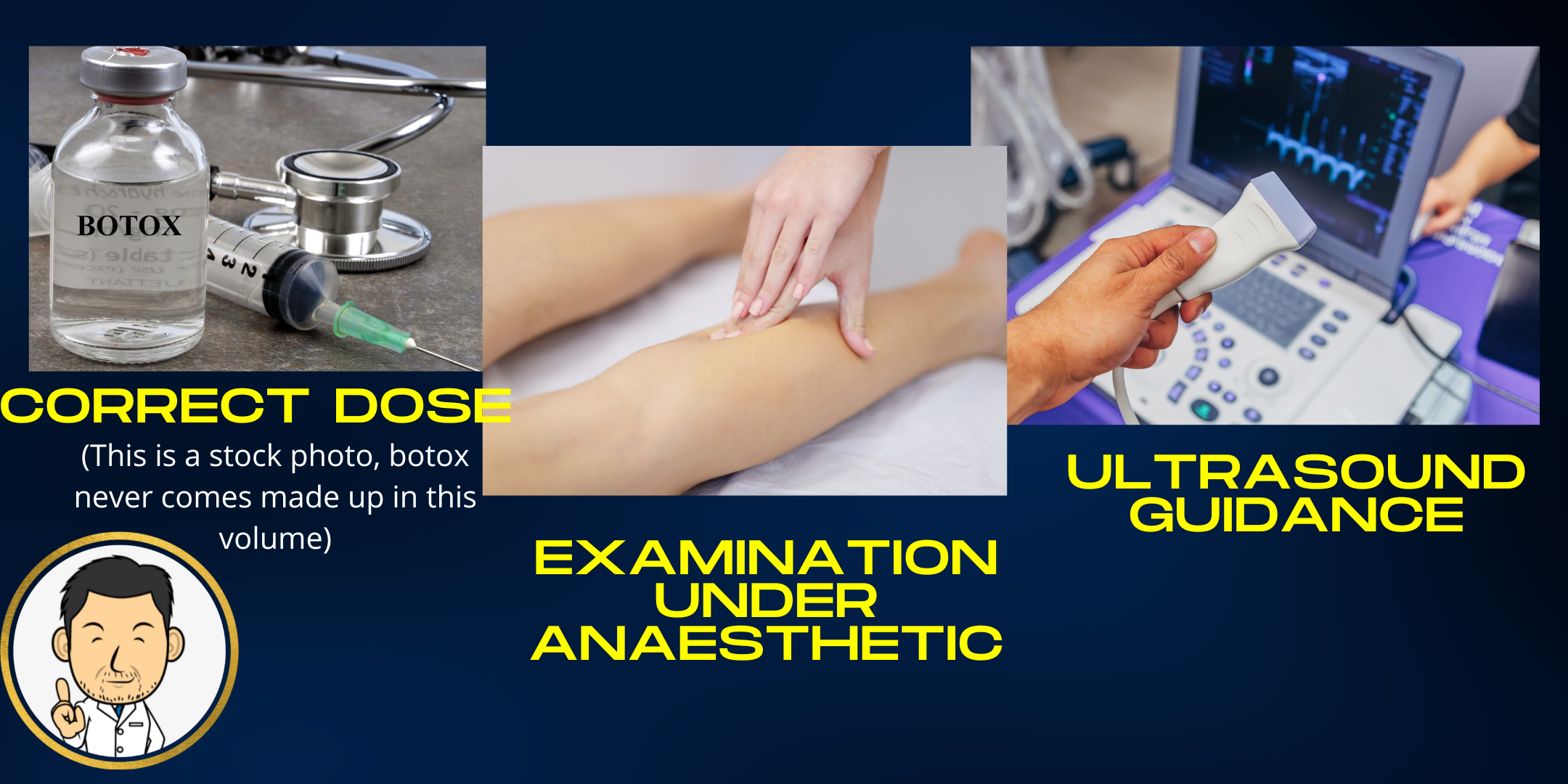Conditions I treat......... Botox administration in Cerebral Palsy

Botulinum toxin, often shortened to Botox, is a bacterial produced neurotoxin which blocks the release of neurotransmitters from nerve endings causing the involved muscle to be temporarily paralysed. Primarily popularised in the media as a cosmetic treatment for frown lines, it's chief medical usage is to address high tone in mucles in cerebral palsy. High tone is what you feel when you encounter resistance to stretching a tight muscle in a patient with cerebral palsy. High tone is very common in cerebral palsy. Over time it can give rise to fixed tightness (muscle contractures) affecting joints and limiting function. In turn, these muscle contractures can lead to progressive bony deformities and joint distortion. Tone management is an important cornerstone in the management of Cerebral Palsy. The aim is to stop affected children developing progressive postural deformities which become stiff and painful over time.
Botox injection is intended to temporarily weaken the targetted muscle making it easier to stretch out. Botox treatment can improve walking in children, make washing and dressing easier for care givers as well as enabling joints to be braced into positions which maximise function. Orthopedic surgeons and rehabilitation physicians have been administering botox for cerebral palsy for many decades to improve posture and gait with clear clincial evidence of benefit. However, as with any medication, any distortion of human physiology intended to accrue benefit also introduces the risk of potential deleterious effects over time.
Although Botox effects are short lived with tone returning as the nerves re-grow, it has become evident that the residual power deficit increases with repeated usage. This is especially the case when a child has received multiple botox treatments over the course of their childhood. Persistant muscle weakness following repeated Botox administration represents a very real risk in children with Cerebral Palsy . Children able to walk with cerebral palsy will often exhibit a dip in function as they progress into their teenage years where the weight:power ratio shifts unfavourably. Maintaining muscle strength is crucial and the potential for repeated Botox administration to cause weakness is a risk against which the benefits must be weighed.
Therfore, it is important to have a strategy of when to employ Botox (and importantly when not to). Guiding principles I use to make this judgement include:
Treatment based on functional gain
High tone in cerebral palsy is a recurrent problem especially during growth. Therefore to administer botox just because muscle tightness is present is insufficient justification. Crucially, there has to be a functional objective that botox will make possible - such as being able to get the foot comfortably into a splint. I am fortunate that I have colleagues in Pediatric Rehabillitation Physician with expertise in making treatment decisions on tone control who I can discuss these cases with. Multi-disciplinary team discussion is crucial for defining a long term plan of tone control throughout growth.
Minimising usage where high tone is coupled with weakness
Many children are reliant on their high tone to enable them to stand and walk with mobility aids. In certain patients, a delicate balance exists sufficient to enable gait. However, repeated Botox administration may risk introducing critical weakness affecting standing and walking potential.
Combining Botox with other therapies to maximise effect
I often use botox in calf muscle tightness and potentiate it's effects by combining it with serial casting and physiotherapy. Botox given under general anaesthetic is beneficial as the child is completely relaxed and I can then put a plaster cast on with maximum stretch on the calf muscles. The Botox takes time to take effect. Reviewing the patient one or two weeks later is an ideal time for the Botox to have taken effect and allows me to re-cast them in an improved ankle positition with even more calf muscle stretch. I will usually re-cast again in one to two weeks for added benefit in improving range of motion. Onwards referral to physiotherapy so that when they come out of cast, an active stretching program is instituted from day one.
Botox injection under general anaesthetic
There are a few advantages to undertaking Botox injections under general anaesthetic.
- Evaluation of muscle tightness and range of movement under anaesthetic in an unconscious child provides important insights into the "true" tone and the extent to which this is voluntarily affected when the child is awake. I usually take this opportunity to perform a complete examination of the range of motion in all four limbs irrespective of which muscle groups I plan to inject.
- Exploring deep muscle groups with a needle is not a pleasant prospect in an adult but in an awake child is even more distressing.
- Botox acts at the interface between nerve and muscle and therefore the number and spatial distribution of injection sites for large muscles is just as important as the volume and concentration injected. It is preferable to deliver the dose split between multiple sites to ensure adequacy of effect rather than a single injection site. Injecting multiple sites in an awake child can be very distressing.
Ultrasound guided Botox injection
Although many muscles are large and easy to identify from surface landmarks, deep muscles in small children may be difficult to identify. Nerve stimulation can help to identify which muscle the needle is advancing into. Ultrasound guided injection enables the needle to be advanced into the muscle under direct vision in real time vastly improving targetting. Crucially in the calf this approach ensures that the soleus muscle is not inadvertedly injected when targetting the gastrocnemius muscle. Weakening the soleus (like lengthening) has a very negative impact on walking ability and ultrasound guidance helps avoid this issue.

Avoiding Botox in fixed contractures
This is fairly straightforward as a muscle tendon unit which has become contracted into a fixed length will not stretch out even if the muscle is relaxed with Botox. Sadly, Botox is often offered in such instances as a "low risk minimalistic" approach which may be more acceptable to patients and parents than the prospect of major surgery.
Avoiding Botox in the hip muscles
Children with Cerebral palsy who are wheelchair users are at significant risk of progressive hip displacement and eventual dislocation. There is sufficient evidence to suggest that once the hips have displaced significantly, botox administration in isolation is insufficient to reverse the dislocation. Single stage hip reconstruction remains the gold standard for treating hip dislocation in children with cerebral palsy and should be considered in all patients where evidence of significant hip displacement exists.
Considering other tone control measures
Baclofen is a muscle relaxant which can be given orally or via an intrathecal pump to aid tone control. It may be used alongside Botox or independently to facillitate comfort in patients with high tone. Selective dorsal rhizotomy (SDR) is a neurosurgical procedure designed to tackle high tone in lower limb muscles. It has demonstrated very good outcomes in carefully selected patients. Age of the child, walking potential, reversible correction of high tone and the specific neuro-anatomical deficit are all carefully considered alongside other factors to determine the likelihood of benefit following this procedure. SDR and Baclofen pump treatment are best delivered in specialised centres where protocol guided patient selection and routine outcomes assessment are part of a well delivered service. These interventions are beyond the scope of my practice. I usually refer or signpost patients to appropriate services for assessment to receive these treatments in aiding tone control.
